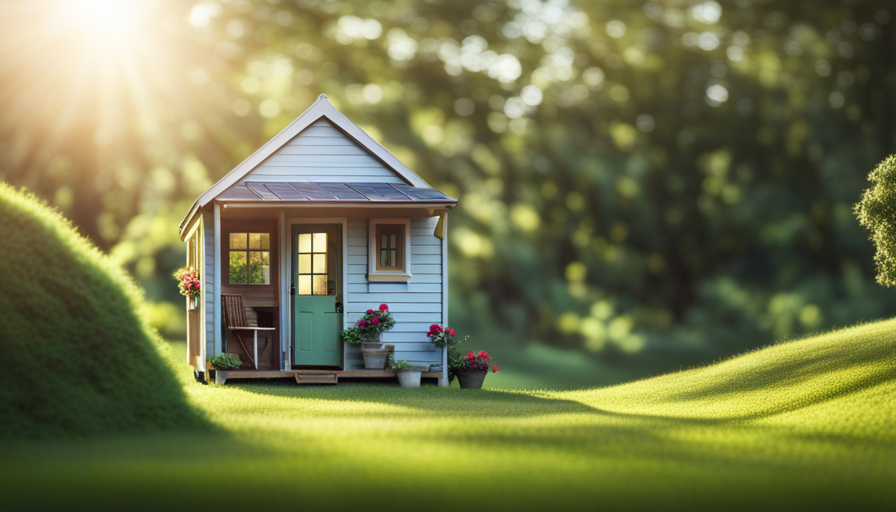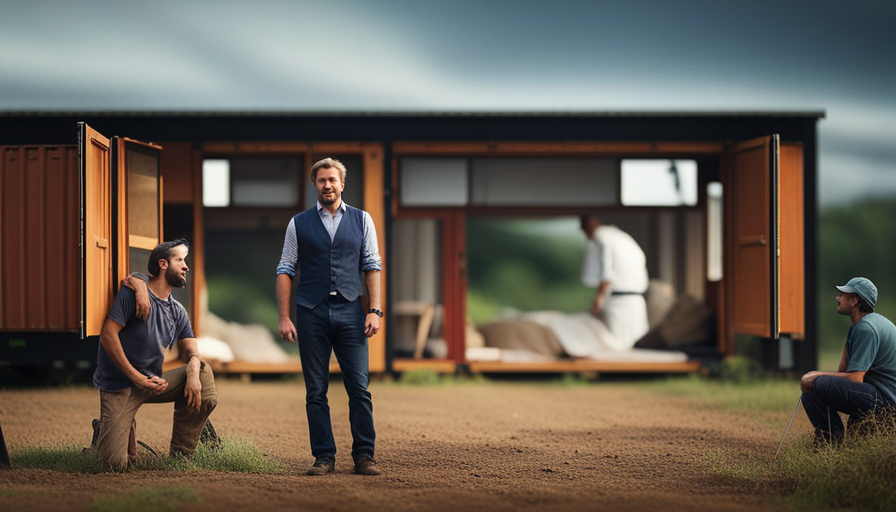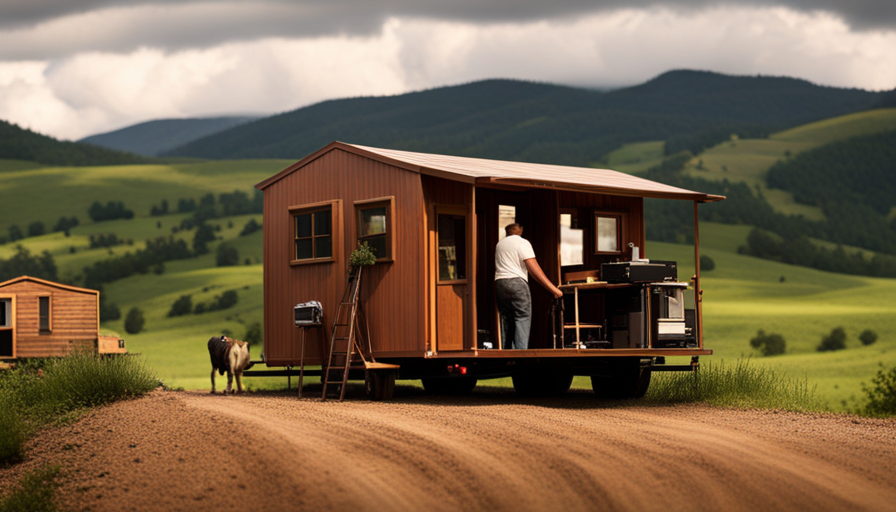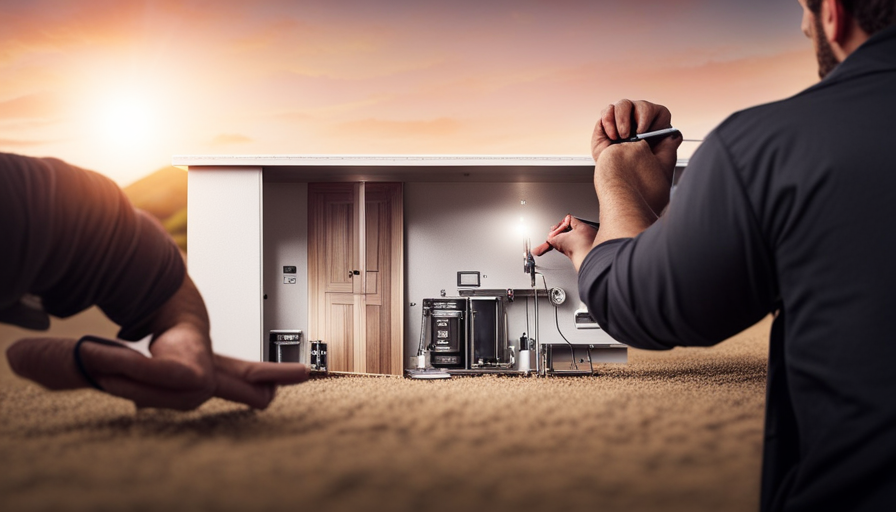Imagine a tiny house as a harmonious symphony of sustainability, where every element collaborates to create a self-sufficient living environment.
Among these elements, solar power takes center stage, orchestrating a greener future. But how big should solar be for a tiny house?
As a solar enthusiast and homeowner of a tiny house, I embarked on a quest to find the perfect solar setup. In this article, I will guide you through the technical aspects of determining the right size for your solar system, ensuring it meets your energy needs while fitting in the limited space available.
We will explore the different types of solar panels and battery storage options, as well as discuss the importance of consulting with a solar professional. Additionally, I will offer insights on planning for future energy needs, calculating return on investment, and taking advantage of incentives and rebates.
So, let’s dive deep into the world of solar power and illuminate the possibilities for your tiny house.
Key Takeaways
- Assess energy needs and consider panel efficiency to determine the right size of solar system for a tiny house.
- Choose high-efficiency panels and consider roof-mounted or ground-mounted installations to maximize energy production in limited space.
- Evaluate energy storage needs, research battery technologies and capacities, and consider other renewable energy sources to supplement the solar system.
- Consult with a solar professional, consider budget considerations and long-term savings, and calculate return on investment to make informed decisions about the size of the solar system for a tiny house.
Assess Your Energy Needs
To accurately assess your energy needs for a tiny house, you’ll need to take into account the number of appliances and devices you plan to use on a daily basis. This involves calculating energy consumption and analyzing solar panel efficiency.
Firstly, make a list of all the electrical appliances you intend to use, such as lights, refrigerator, television, and water heater. Find the power rating in watts for each appliance and multiply it by the number of hours you expect to use them each day. Add up the total to get an estimate of your daily energy consumption.
Next, consider the efficiency of the solar panels you plan to install. Solar panel efficiency refers to the amount of sunlight that is effectively converted into usable electricity. Panels with higher efficiency will require fewer square feet of space to generate the same amount of power. Research different solar panel brands and models to find the most efficient option for your needs.
To determine available space, you’ll need to consider the size and layout of your tiny house. Take into account the roof space, as well as any additional areas where solar panels could be installed, such as a nearby shed or awning.
By assessing your energy needs and considering solar panel efficiency, you can determine the appropriate size of your solar system for your tiny house.
Determine Available Space
The amount of space required for solar panels in a tiny house can be mind-blowingly minuscule. When it comes to determining available space for solar panels, there are a few key factors to consider in order to maximize efficiency and optimize energy production.
-
Roof space: The roof is usually the most common and practical location for solar panel installation. Assess the available roof space and consider the orientation and tilt of the roof to ensure maximum sunlight exposure throughout the day.
-
Ground space: If the roof space is limited or not suitable for solar panels, ground space can be utilized instead. Determine if there is enough open area around the tiny house to install solar panels on the ground. This may require additional planning to ensure proper mounting and alignment for optimal energy production.
-
Portable options: In some cases, space constraints may make it challenging to install permanent solar panels. Portable solar panels are a great alternative, allowing you to move and adjust them to capture the most sunlight throughout the day.
By considering these factors and assessing the available space, you can determine the best location for solar panels in your tiny house. Choose the right type of solar panels to ensure maximum efficiency and energy production.
Transitioning into the subsequent section, choosing the right type of solar panels is crucial for optimizing the overall performance of your solar system.
Choose the Right Type of Solar Panels
Maximize your solar system’s performance by selecting the perfect type of panels for your tiny home. When it comes to solar panels, one of the most important factors to consider is their efficiency. The efficiency of a solar panel determines how much sunlight it can convert into electricity. Since space is limited in a tiny house, it’s crucial to choose panels with high efficiency to maximize energy production.
High-efficiency panels can generate more electricity in a smaller area compared to lower efficiency ones. Additionally, the type of solar panel installation you choose can also impact the performance of your system. There are two main types of installations: roof-mounted and ground-mounted.
Roof-mounted installations are the most common choice for tiny houses due to their space-saving advantage. However, ground-mounted installations can be a great option if you have enough space available around your tiny home.
Consider battery storage options to ensure you have a reliable power supply even when the sun isn’t shining. Transitioning to the next section, we’ll explore the different battery storage options that can complement your solar system and provide you with uninterrupted power.
Consider Battery Storage Options
When considering battery storage options for my tiny house, it’s important to evaluate my energy storage needs. This involves assessing how much energy I’ll need to store and for how long, as well as any specific requirements I may have.
Additionally, researching different battery technologies and capacities is crucial to ensure I choose the most suitable option for my needs. It’s essential to understand the different types of batteries available, their pros and cons, and their compatibility with my solar system.
Evaluate Your Energy Storage Needs
Consider how much energy you’ll need to store in order to power your tiny house with solar, and don’t underestimate the impact it can have on your overall sustainability goals. Evaluating your energy storage needs is crucial to ensure that your solar system can meet your power demands.
Start by evaluating your energy production, taking into account factors such as the size and orientation of your solar panels, as well as the average amount of sunlight in your area. Additionally, consider incorporating other renewable energy sources, such as wind or hydro power, to supplement your solar system. This will help you optimize your energy production and reduce dependence on the grid.
Research different battery technologies and capacities to find the best solution to store and utilize the energy generated by your solar system effectively. Understanding battery options is essential for maximizing the efficiency of your solar-powered tiny house.
Research Different Battery Technologies and Capacities
Exploring various battery technologies and capacities is crucial for optimizing the efficiency of your solar-powered small dwelling. With the constant advancements in battery technology, it’s important to stay updated on the latest options available.
One key factor to consider is the energy density of the battery, which refers to the amount of energy it can store in relation to its weight and size. Lithium-ion batteries, for example, have higher energy densities compared to lead-acid batteries, making them a popular choice for solar applications.
Additionally, it’s essential to compare the efficiency of different battery technologies, as this can greatly impact the overall performance of your solar system. By selecting a battery with high efficiency, you can ensure that more of the energy generated by your solar panels is effectively stored and utilized.
To make an informed decision, consulting with a solar professional is highly recommended. They can provide valuable insights and help you choose the best battery technology and capacity for your specific needs.
Consult with a Solar Professional
To ensure the optimal size of your solar system for your tiny house, it’s essential to consult with a solar professional who can guide you through the process. A solar professional will take into account various factors, including budget considerations and solar panel placement, to determine the right size of your solar system.
Budget considerations play a crucial role in determining the size of your solar system. A solar professional will assess your budget and help you choose the most cost-effective solar panels and battery technologies that meet your energy needs. They will also consider the long-term savings that solar energy can provide, helping you make an informed decision about your investment.
Solar panel placement is another key aspect that a solar professional will consider. They will evaluate your tiny house’s location, orientation, and available roof space to determine the optimal placement for the solar panels. This ensures maximum sun exposure and energy production throughout the day.
By consulting with a solar professional, you can be confident that your solar system will be appropriately sized for your tiny house. Once you have determined the right size, you can move on to the next step and look for energy-efficient appliances and systems that will further optimize your energy usage.
[Transition: Now that you have the optimal size of your solar system, it’s time to look for energy-efficient appliances and systems to complement your solar setup.]Look for Energy-Efficient Appliances and Systems
When it comes to energy efficiency in a tiny house, it’s crucial to consider the appliances and systems you choose. Opting for Energy Star certified appliances ensures that you’re using products that meet strict energy efficiency guidelines.
Additionally, it’s essential to consider energy-efficient heating, cooling, and water systems to minimize energy consumption and reduce your carbon footprint. By prioritizing these key points, you can significantly enhance the energy efficiency of your tiny house and create a more sustainable living environment.
Opt for Energy Star Certified Appliances
Consider choosing appliances that are Energy Star certified to ensure maximum energy efficiency in your tiny house. Energy Star is a government-backed program that promotes energy-efficient products, including appliances, lighting, and electronics. By opting for Energy Star certified appliances, you can save energy and reduce your electricity bills. These appliances are designed to use less energy without sacrificing performance or quality. They incorporate advanced technologies such as improved insulation, efficient motors, and smart features that automatically adjust power usage. Additionally, Energy Star certified appliances often come with a higher solar panel efficiency rating, making them an excellent choice for solar-powered tiny houses. Investing in energy-efficient appliances not only benefits the environment but also enhances the overall sustainability of your tiny house. Transitioning into the next section, consider energy-efficient heating, cooling, and water systems to further optimize your tiny house’s energy consumption.
Consider Energy-Efficient Heating, Cooling, and Water Systems
Installing energy-efficient heating, cooling, and water systems can significantly reduce energy consumption in your small living space, leading to lower utility bills and a more sustainable lifestyle. Here are three key ways energy-efficient systems can benefit your tiny house:
-
Energy-efficient insulation: Properly insulating your home can prevent heat loss in the winter and keep it cool in the summer. This means less reliance on heating and cooling systems, resulting in reduced energy usage.
-
Renewable energy sources: Consider integrating renewable energy sources like solar panels or wind turbines into your tiny house. These systems generate clean, sustainable power, reducing your reliance on traditional energy sources.
-
Efficient water systems: Opt for low-flow faucets, showerheads, and toilets to conserve water. Additionally, consider installing a solar water heater to further reduce energy consumption.
By implementing these energy-efficient strategies, you can minimize your ecological footprint and save on energy costs. Planning for future energy needs is essential to ensure the sustainability of your tiny house.
Plan for Future Energy Needs
To ensure a sustainable and self-sufficient future, it is essential to envision a solar system that perfectly meets the energy needs of a tiny house. When planning for future energy needs, it is important to consider the long-term sustainability of your solar system and explore renewable energy options. By investing in a solar system that can generate more energy than your current needs, you can potentially expand your tiny house or add energy-intensive appliances without worrying about exceeding your system’s capacity.
To help you visualize the benefits of planning for future energy needs, consider the following table:
| Energy Needs | Current System Capacity | Future System Capacity |
|---|---|---|
| Lighting | 200 watts | 200 watts |
| Appliances | 500 watts | 800 watts |
| Heating | 1000 watts | 1500 watts |
| Cooling | 800 watts | 1200 watts |
| Water Systems | 300 watts | 500 watts |
As you can see, by planning for future energy needs, you can ensure that your solar system is capable of meeting the increasing demands of your tiny house. This proactive approach will save you from the hassle and cost of upgrading your system later on.
In the next section, we will calculate your return on investment, taking into account the energy efficiency of your solar system and the potential savings it can provide.
Calculate Your Return on Investment
In order to calculate the return on investment for a solar system, I’ll need to determine the cost of the system first. This includes the cost of the solar panels, installation, and any additional equipment.
Once I have the cost, I can estimate the savings that the solar system will provide by reducing or eliminating my electricity bill.
Finally, I can calculate the payback period, which is the length of time it’ll take for the savings to equal or exceed the initial cost of the system.
Determine the Cost of the Solar System
When considering the size of your solar system for a tiny house, how much will it cost you? Evaluating solar efficiency and comparing solar prices are crucial steps in determining the cost of the solar system. To make an informed decision, consider the following:
-
Solar efficiency: Evaluate the efficiency of different solar panels to determine how much energy they can generate. Higher efficiency panels may cost more initially, but they can generate more electricity in the long run, potentially offsetting the higher cost.
-
Solar prices: Compare prices from different solar providers to find the best deal. Consider the cost of the panels, installation, and any additional equipment or maintenance fees.
-
Incentives and rebates: Research any available incentives or rebates that can help lower the overall cost of the solar system.
By evaluating solar efficiency and comparing prices, you can determine the cost of the solar system that best suits your needs. Transitioning into the next section, estimating the savings and payback period, you can further analyze the financial benefits of installing a solar system for your tiny house.
Estimate the Savings and Payback Period
In determining the cost of the solar system for a tiny house, it is crucial to estimate the savings and payback period. This allows us to understand the financial viability of investing in solar panels. One important factor to consider is solar panel efficiency, which refers to the amount of sunlight the panels can convert into usable electricity. Higher efficiency panels generate more electricity, resulting in greater savings over time. Additionally, net metering benefits should be taken into account. Net metering allows homeowners to sell excess electricity back to the grid, further reducing their energy costs. By analyzing these factors, we can determine the potential savings and calculate the payback period for the solar system. Now, let’s move on to the next step and research available incentives and rebates for installing solar panels.
Research Available Incentives and Rebates
When researching available incentives and rebates for solar energy, it’s important to look for Federal, State, and Local solar incentives. These incentives can greatly reduce the cost of installing solar panels and make it more affordable for homeowners.
Additionally, it’s worth exploring financing options and tax credits that may be available, as these can further offset the upfront costs and provide long-term financial benefits.
Look for Federal, State, and Local Solar Incentives
To maximize the benefits of solar power for your tiny house, don’t forget to explore the various federal, state, and local incentives available to help make your green dreams come true! When it comes to solar incentives, both the federal government and individual states offer a range of programs to encourage the adoption of renewable energy.
Here are a few key incentives to consider:
-
Federal solar incentives: The federal government provides a tax credit known as the Investment Tax Credit (ITC), which allows you to deduct a percentage of your solar installation costs from your federal taxes.
-
State solar incentives: Many states have their own incentives, such as grants, rebates, and tax credits, to make solar more affordable. These incentives vary by state, so it’s important to research what is available in your area.
By taking advantage of these federal and state solar incentives, you can significantly reduce the cost of your solar installation.
Now, let’s explore financing options and tax credits to further support your solar journey.
Explore Financing Options and Tax Credits
Consider exploring financing options and tax credits to help pave the path towards a brighter and more sustainable future for your eco-friendly abode. When it comes to financing your solar system, there are several options available. You can choose to purchase the system outright, which allows you to take advantage of long-term savings. Alternatively, you can opt for solar loans, which provide you with the flexibility to pay for the system over time. Additionally, there may be local incentives and rebates that can further reduce the cost of installation. On the other hand, tax credits can significantly offset the upfront expenses of going solar. The federal investment tax credit (ITC) allows you to deduct a portion of your solar system’s cost from your federal taxes. It’s essential to explore these financing options and tax credits to make solar energy more affordable for your tiny house. By doing so, you can maximize your savings and minimize your carbon footprint.
| Financing Options | Tax Credits |
|---|---|
| Outright Purchase | Investment Tax Credit (ITC) |
| Solar Loans | Local Incentives and Rebates |
To ensure the long-term performance and efficiency of your solar system, it is crucial to regularly monitor and maintain it.
Regularly Monitor and Maintain Your Solar System
Regularly monitoring and maintaining your solar system is crucial for keeping it in peak performance. As a tiny house owner, it’s important to stay on top of your solar system’s performance to ensure that it’s generating the maximum amount of energy possible. By regularly monitoring your system, you can identify any issues or inefficiencies that may arise and take prompt action to address them.
A key aspect of monitoring your solar system is keeping track of its performance. This can be done through a monitoring system that provides real-time data on the energy production of your solar panels. By regularly reviewing this data, you can identify any fluctuations in performance and take steps to rectify them.
Additionally, monitoring system performance allows you to track the overall energy production of your system over time, helping you assess its long-term efficiency.
In addition to monitoring system performance, it’s important to be familiar with common solar issues and how to troubleshoot them. Some common issues include shading on the solar panels, loose connections, or malfunctioning inverters. By regularly inspecting your solar system and conducting routine maintenance, you can identify and address these issues before they cause significant problems.
Overall, regularly monitoring and maintaining your solar system is essential for optimizing its performance and ensuring its longevity. By staying proactive and addressing any issues that arise, you can enjoy the full benefits of solar energy in your tiny house.
Frequently Asked Questions
What are the different types of solar panels available for small houses?
In terms of different solar panel technologies for small houses, there are mainly three types: monocrystalline, polycrystalline, and thin-film.
Monocrystalline panels are highly efficient but expensive.
Polycrystalline panels are more affordable but slightly less efficient.
Thin-film panels are the least expensive but have the lowest efficiency.
The choice depends on the budget and energy requirements of the house. Ultimately, it’s important to weigh the pros and cons of each technology to make an informed decision.
How do I determine the amount of space required for installing solar panels on my tiny house?
To determine the space required for installing solar panels on my tiny house, I need to consider the solar panel efficiency and the amount of energy I want to generate. Solar panel efficiency refers to the percentage of sunlight that can be converted into usable electricity. By calculating this efficiency, I can estimate how many solar panels I’ll need based on my energy needs.
For example, with an average efficiency of 20%, each square foot of solar panel can generate around 15 watts of electricity.
Is it necessary to install a battery storage system for a tiny house solar setup?
It’s not necessary to install a battery storage system for a tiny house solar setup. However, it can be beneficial depending on your energy needs. Battery lifespan is an important consideration when deciding on a battery storage system.
The pros of battery storage include the ability to store excess energy for later use and provide backup power during outages. However, the cons include the cost of installation and maintenance, as well as the limited lifespan of batteries.
How can I ensure that my solar system is running efficiently and effectively?
To ensure maximum solar efficiency, I follow a few key steps.
First, I regularly monitor my solar system’s performance using a monitoring app or software. This helps me identify any issues or inefficiencies.
Second, I keep my solar panels clean and free from debris, as dirt can reduce their effectiveness.
Lastly, I address common solar system issues, such as shading or faulty wiring, promptly to maintain optimal performance.
What are the financial incentives or rebates available for installing solar panels on a tiny house?
There are several financial incentives and government rebates available for installing solar panels on a tiny house. These incentives and rebates vary depending on location and can significantly offset the initial cost of installation.
Some examples include federal tax credits, state-level incentives, and utility company rebates. Additionally, certain regions offer net metering programs, allowing you to earn credits for excess energy produced.
It’s important to research and consult local authorities to determine the specific incentives available in your area.
Conclusion
In conclusion, determining the appropriate size of the solar system for a tiny house requires careful consideration of energy needs, available space, and future requirements. Consulting with a solar professional is crucial to ensure the best choice of solar panels and battery storage options.
It is also essential to calculate the return on investment and research available incentives and rebates. Regular monitoring and maintenance of the solar system are necessary for optimal performance.
Remember, "measure twice, cut once" when it comes to sizing your solar system for a tiny house.
Hi, I’m Emma. I’m the Editor in Chief of Tiny House 43, a blog all about tiny houses. While tree houses are often associated with childhood, they can be the perfect adult retreat. They offer a cozy space to relax and unwind, surrounded by nature. And since they’re typically built on stilts or raised platforms, they offer stunning views that traditional homes simply can’t match. If you’re looking for a unique and romantic getaway, a tree house tiny house might just be the perfect option.










